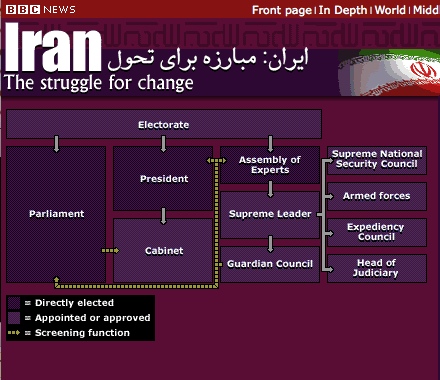I am baffled by the power-structure in Iran — all those councils of ‘experts’ and ‘guardians’ and the so-called ‘supreme leader’ (the title Private Eye shrewdly assigned to Gordon Brown, incidentally). “What I need”, I said to an Iranian friend, “is a diagram” (for I am but an humble engineer and long words trouble me). She immediately emailed a link to this helpful clickable BBC chart.
Looks clear, doesn’t it? But then you find that the Guardian Council, which appears to be way down the pecking order, is apparently
the most influential body in Iran and is currently controlled by conservatives. It consists of six theologians appointed by the leader and six jurists nominated by the judiciary and approved by parliament. The council has to approve all bills passed by parliament and make sure they conform to the constitution and Islamic law. The council also has the power to veto candidates in elections to parliament, local councils, the presidency and the Assembly of Experts. President Khatami is attempting to remove this power.
The Assembly of Experts, for its part, is
made up of 96 clerics, is comparable to the College of Cardinals which chooses the Pope. The assembly is elected directly by the electorate every eight years. Its functions are to appoint, oversee and if necessary dismiss the Supreme Leader. It meets twice a year to review the performance of the Supreme Leader.
“The current assembly”, the BBC chart helpfully reveals, “was elected in 1998 for an eight-year term”. Er, 1998 plus 8 equals 2006. It is now 2009. Well, it is here in the Junior Satanic Kingdom of Britain anyway. In the governing circles in Iran it’s probably about 1456.
On the other hand… Just think if the College of Cardinals met twice-yearly to review the performance of the Pope. That’d soften the old boy’s cough, as my mother used to say. Keep him up to the mark.

